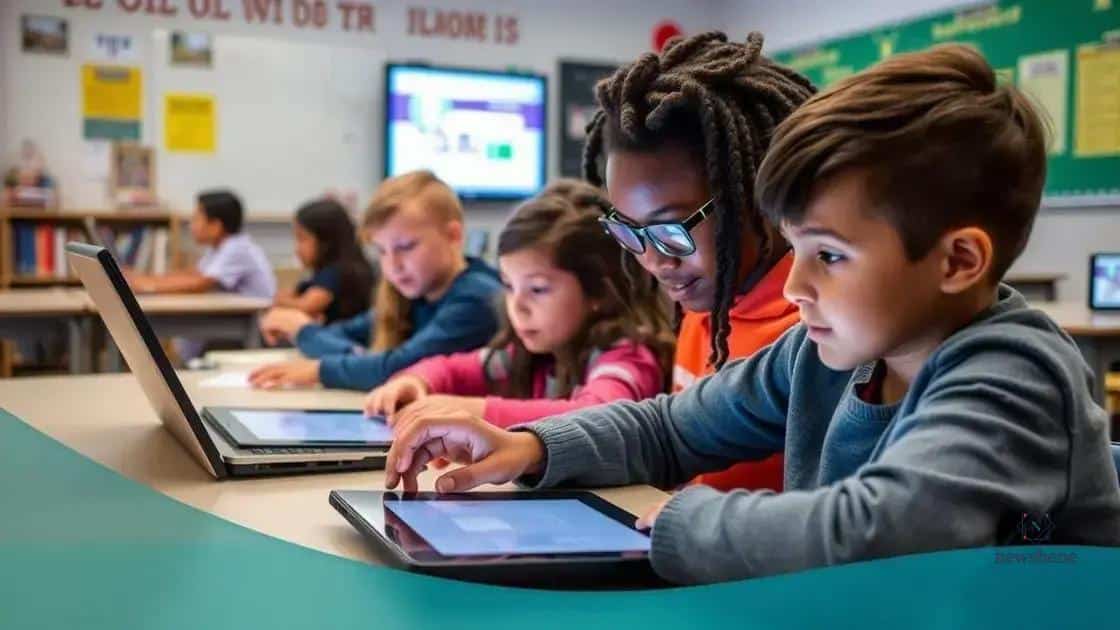Government funding for digital and remote learning tools

Government funding for digital and remote learning tools is essential for enhancing educational access and equity, providing necessary resources to underserved schools and improving student engagement and outcomes.
Government funding for digital and remote learning tools is shaping the future of education by enhancing accessibility and innovation. Have you ever pondered how funding unlocks opportunities for students and teachers alike?
Understanding government funding for education
Understanding government funding for education is essential for grasping how resources are allocated to schools and students. This funding plays a crucial role in shaping educational opportunities.
What is Government Funding?
Government funding refers to financial support from local, state, or federal agencies designated for educational institutions. This funding is often aimed at enhancing the quality of education, providing necessary tools, and ensuring that every student has access to the learning environment they need.
Types of Government Funding
There are several types of funding available:
- Grants: Often for specific projects or programs that enhance learning.
- Loans: Financial aid that needs to be paid back, often available for institutions.
- Per-pupil funding: Allocated based on the number of students enrolled in a school.
- Title I funding: Targeted towards schools with high percentages of low-income students.
Each type serves a unique purpose, helping schools to improve facilities and resources. Understanding these aspects helps stakeholders in education make informed decisions about resource allocation.
Government funding can significantly impact a school’s capability to provide quality education. For instance, when funding is sufficient, schools can invest in better digital learning tools, hire more staff, or offer enhanced training programs for teachers. Schools receiving substantial grants often show noteworthy improvements in student outcomes.
The Importance of Funding in Educational Equity
Equitable funding is vital in addressing disparities in education. Schools in low-income areas often struggle with limited resources, making it difficult to provide a quality education. Understanding how government funding is distributed can highlight inequities and inconsistencies in the system.
By analyzing funding sources, community leaders and educators can advocate for necessary changes to promote educational equity. As schools receive more funding, they can create diverse programs that meet the unique needs of their students, paving the way for success.
How Funding Affects Learning Tools
As funding increases, schools can afford to incorporate modern technology into their curriculum. For instance, they can purchase digital learning tools, such as tablets and online resources, which enhance student engagement.
This shift not only keeps students interested but also prepares them for a technology-driven world. The availability of such tools bridges gaps in knowledge and increases competitiveness among students.
Ultimately, understanding government funding for education unveils the importance of financial resources in shaping the future of education. By actively participating in funding discussions, educators and policymakers can work together to create a brighter future for students nationwide.
Types of digital and remote learning tools
Understanding the types of digital and remote learning tools is essential for educators and students alike. These tools have transformed how learning occurs and can cater to various learning needs.
Online Learning Platforms
Online learning platforms offer a range of courses and resources that students can access from anywhere. They often include:
- Video lectures: Engaging presentations that can be watched multiple times.
- Interactive quizzes: Helping students test their knowledge immediately.
- Course materials: Downloadable books and articles for deeper learning.
These platforms provide flexibility and convenience, allowing learners to study at their own pace.
Collaboration Tools
Collaboration tools foster teamwork among students and teachers, regardless of location. Some popular options include:
- Virtual classrooms: Providing a shared space for discussions and lectures.
- Group projects: Tools like Google Drive or Microsoft Teams allow real-time collaboration.
- Discussion forums: Places for students to ask questions and share ideas.
These tools not only enhance communication but also create a sense of community among learners.
Furthermore, learning management systems (LMS) play a significant role in organizing courses and tracking student progress. An LMS keeps all resources in one place and allows educators to manage assignments effectively. This centralization helps both teachers and students by providing easy access to essential materials.
Mobile applications have also gained popularity as essential digital learning tools. They enable students to learn on the go, making education more accessible than ever. These apps can include everything from language learning to math games, catering to varying learning styles.
As technology continues to evolve, the landscape of digital learning will keep changing. With new tools emerging, educators can provide enriched learning experiences tailored to their students’ needs. By leveraging these remote learning tools, schools can help bridge the gap in education, making learning both effective and engaging.
Impact of funding on educational equity

The impact of funding on educational equity is a crucial topic in today’s educational landscape. Adequate funding can ensure that all students have access to the resources they need to succeed.
Understanding Educational Equity
Educational equity means providing equal access to learning opportunities for all students, regardless of their background. When schools are funded fairly, they can provide resources that meet diverse student needs. This means tackling issues like outdated technology, inadequate classrooms, and limited access to experienced teachers.
How Funding Levels Create Disparities
Funding disparities can directly affect the quality of education that students receive. Schools in affluent areas often receive more funding than those in lower-income regions. This can lead to:
- Enhanced facilities: Wealthier schools can afford better infrastructure and modern learning tools.
- More academic programs: Higher funding allows schools to offer diverse courses and extracurricular activities.
- Effective teacher recruitment: Schools with more resources can attract and retain qualified educators.
These differences can hinder students from lower socioeconomic backgrounds, limiting their chances for success.
Furthermore, targeted funding initiatives, such as Title I programs, aim to address these inequalities. By focusing on schools with higher percentages of low-income students, these programs can help level the playing field. However, the effectiveness of such programs depends on the amount of funding available to them.
Additionally, when funding focuses on under-resourced schools, it can greatly improve educational environments. Investing in teacher training and support systems can greatly increase student engagement and achievement. Schools that prioritize equitably distributing funds can create a more balanced educational experience for all.
As we explore the impact of funding on educational equity, it’s evident that how money is allocated has profound effects on student outcomes. A commitment to equitable funding can lead to innovation in teaching methods, improved student performance, and ultimately, a brighter future for all learners.
Success stories of funded programs
Success stories of funded programs highlight the positive impact that government funding can have on education. These programs demonstrate how financial support can lead to significant improvements in student outcomes.
Case Studies of Effective Programs
One standout example is the STEM-focused initiative that received funding to enhance science and technology education in underprivileged areas. This program introduced hands-on experiments and modern technology to students, allowing them to engage in learning actively.
Impact on Student Engagement
As a result, many students reported a greater interest in pursuing careers in science and technology. This program not only increased engagement but also improved overall academic performance.
Challenges Overcome
Another success story comes from a rural school district that received funding for digital learning tools. Initially, the school faced challenges due to limited resources and outdated materials. However, with government support, they were able to upgrade their technology, providing students with tablets and access to online learning platforms.
Through this initiative, the district saw improvements in students’ ability to complete assignments and participate in collaborative projects. Many reports indicated higher test scores and better preparation for higher education.
These examples illustrate the transformative power of funding in education. Programs that implement effective strategies can cater to diverse student needs. When resources are allocated wisely, they can bridge gaps in educational access and equity.
The success of these funded programs inspires other schools and districts to seek similar support, demonstrating that with the right resources, education can truly thrive.
Future of government funding in education
The future of government funding in education looks promising as governments increasingly recognize the need for investment in educational resources. With advancements in technology and evolving educational needs, funding strategies are expected to adapt and grow.
Innovative Funding Models
As we move forward, innovative funding models may emerge to provide more equitable distribution of resources. Some possibilities include:
- Performance-based funding: Schools could receive funding based on student performance and outcomes, promoting accountability.
- Community partnerships: Collaborations between schools and local businesses can create additional funding streams.
- Federal grants: Enhanced grant programs could target specific needs, such as technology integration or support for disadvantaged students.
These new models can help ensure that funding is directed to where it is most needed.
Focus on Equity and Access
In the future, there will likely be a stronger emphasis on equity and access in education funding. Policymakers are becoming more aware of the disparities that exist within school systems. By prioritizing funds for under-resourced schools, there’s potential to create a more level playing field.
Programs that support low-income students and provide necessary resources can help close achievement gaps. Investing in teacher training and support services will also be critical for educational success.
The influence of technology on education funding will continue to grow. As more schools adopt digital learning tools, funding will need to keep pace. This will ensure that students have access to the latest resources and educational opportunities.
Moreover, future funding strategies may incorporate community feedback, enabling local stakeholders to voice their concerns and needs. Engaging the community helps cultivate a more tailored approach to education funding.
As we consider the future of government funding in education, it’s evident that bold changes are on the horizon. Embracing innovation and collaboration will be key to fostering a more effective and equitable educational landscape.
FAQ – Frequently Asked Questions about Government Funding in Education
What is government funding for education?
Government funding for education refers to financial support provided by local, state, or federal governments to schools and educational programs.
How does funding affect educational equity?
Funding plays a crucial role in educational equity by ensuring that resources are allocated to under-resourced schools, helping to close achievement gaps.
What are some success stories of funded educational programs?
Success stories include programs that have used funding to improve technology access, enhance curriculum, and boost student engagement in learning.
What does the future of education funding look like?
The future may involve innovative funding models focused on equity, technology integration, and community partnerships to enhance educational access.






